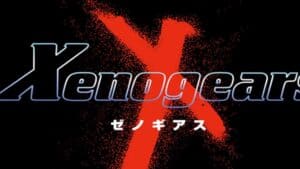Backlogvania Review – Harmony of Dissonance
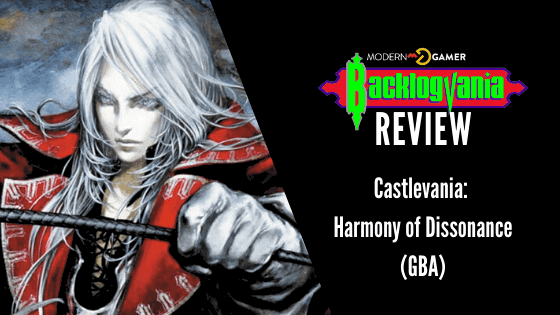
Welcome to Backlogvania
Join me each month as I tackle one game from my backlog, try to complete it in a month, and then tell you if it’s worth playing now, leaving in your backlog, or skipping completely. Not that my opinion means anything, but you’re here. You have now entered the daunting, and traitorous world of Backlogvania!
This month’s game is…
Game: Castlevania: Harmony of Dissonance
System: GameBoy Advance
Released: 2002
Publisher: Konami
Notable Creatives: Koji “Iga” Igarashi
Metacritic Score: 87
Duration in my backlog: 10 months
Additional writing and editing: Joseph McBride
History Lesson
Castlevania is a franchise that hasn’t had what you could call a stable history. The first entry known in the US as Castlevania (Akumajō Dracula or “Devil’s Castle Dracula” in Japan) is a horror-themed action-adventure platformer that is as brutal and controller-smashingly difficult as it is endlessly captivating and rewarding. Upon release, Castlevania was well received and has since been elevated in the annals of gaming history. Its success spawned several sequels with varying degrees of quality, difficulty and critical reception; one of those sequels is listed among gaming’s greatest of all time, Castlevania: Symphony of the Night.
There it is. You knew it was coming. You knew we couldn’t have an adult discussion about a Castlevania game without someone breaking their arm patting that game on the back. When Castlevania is the focus of discussion, it’s difficult to avoid name-dropping Symphony of the Night, and for good reason. It is a seminal, genre-defining masterpiece; it is a groundbreaking title that has become the mechanical and thematic definition of Castlevania. It also contains the best voice acting of any game of its generation second only to Resident Evil.
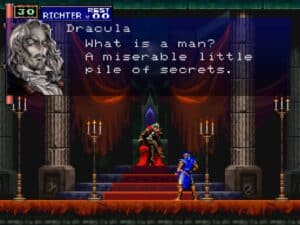
Aside from being a masterpiece, Symphony was also a disruptive force for the ‘Vania games and since its debut the series’ mainline titles have been split into two main styles. Subsequent entries have been either tightly fitted meticulous 2D Metroidvania games or big-budget, latest-gen 3D adventure platformers that depart from the series’ roots. Because of this distinction, almost all of the 2D releases were relegated to handheld systems which in turn served to limit their presence in the market in favor of the more ubiquitous home consoles. Their reach being limited may have also played a part in why I was so late to the party with the subject of this piece, Castlevania: Harmony of Dissonance, even though I was a proud owner of a GameBoy Advance at the time of its release.
Overcoming its low reach, Harmony was a milestone title as it saw the return of Koji Igarashi as writer and producer. Igarashi was not part of the team who worked on the previous game and he sought to create a piece that was far closer in lineage to its legendary predecessor while aiming to improve upon some of the criticisms of Harmony’s immediate predecessor, Circle of the Moon. Harmony not only saw the return of Igarashi, but also the artist who worked on the character designs for Symphony, Ayami Kojima, which lends to both its distinct look and feel. The effort spent to closely emulate the franchise’s best game did not benefit Harmony as critics found the other two Castlevania games on the GameBoy Advance to be superior. But does that mean it’s not worth checking out? Should you play it, backlog it, or skip it? Let’s find out as we review Harmony of Dissonance.
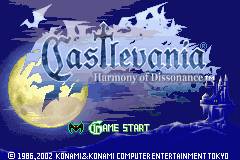
Journey to the Backlog
How I got Harmony into my backlog actually starts all the way at the beginning with Castlevania’s original sequel. Castlevania II: Simon’s Quest has been described as… *checks notes*… a “horrible steaming pile of goat shit” and is considered to be the worst of the “Classicvania” games. I didn’t own a copy of Simon’s Quest but almost everyone I knew growing up had it, whether on the original Nintendo or in the form of every kid’s Christmas disappointment: the Tiger Electronic game.

I was never able to complete Simon’s Quest because I didn’t have dedicated time with it and, let’s be fair, some of the game’s criticisms are valid. Legend has it that anyone who could beat this game without a guide, maxing their parents’ credit card on the Nintendo tip hotline, or some other divine intervention deserved all your Dunkaroos as tribute. It’s not overly difficult as much as it is LOUSY with obscure objectives required to advance the game. Despite its flaws, I enjoyed the gameplay mechanics and it still planted the seed that would eventually grow into my love for the series.
Since Simon’s Quest, I only dabbled in the series while never committing to any of the games full stop. That failure to commit remained until I discovered Bloodstained: Curse of the Moon (Nintendo Switch, 2018), a love letter to 8-bit Castlevania. Curse of the Moon awakened the nostalgia within me and I began the hunt for the original ‘Vania games to feed on. Enter the Castlevania Anniversary Collection which let me play through all of the Classicvania titles including finally conquering Simon’s Quest. Next, I scoured eBay and snagged Harmony of Dissonance but I placed it on my backlog in favor of playing Rondo of Blood and the aforementioned Symphony of the Night. Even with needing to purchase both the games themselves as well as the consoles to play them on, both Rondo and Symphony’s lineage had sunk their teeth in first and I succumbed knowing one day I’d return to play Harmony.
Harmony continued to spend time on my backlog, about 10 months in total, because I simply had other games I wanted to play and or collect. Being a parent with a job is also a real stake in the heart if you’re looking to plow through a bunch of old video games you bought on eBay. Life’s challenges notwithstanding, I have every intention to play the games I’ve collected and I just needed something to get me out of the collector’s coffin. While staying up late one night, I was on a YouTube binge watching classic game reviews and I felt inspired to start combing through the dust collectors on my backlog. Not only did I have a revelation to start playing them, but I was also inspired to document my journey for others. It seemed logical to start with Harmony of Dissonance as it was, at the time, the longest tenured and un-played ‘Vania game in my catalog. So, I dusted off my GameBoy Advance SP, quickly realized I no longer had the same size hands that I did at 17, and switched over to my DS Lite to begin the full playthrough of Harmony of Dissonance.
Game Review
**Warning: This section may contain spoilers for Harmony of Dissonance. You’ve been warned.**
Harmony takes place about 50 years after Simon’s Quest (chronologically) and you play as Simon’s grandson Juste Belmont (not sure if it’s pronounced Yoost or Juiced, but with that physique he’s definitely ‘Juiced,’ amirite?) who travels with his friend Maxim in search of their mutual friend Lydie who has gone missing. They follow her trail to Dracula’s Castle where they find she’s being held captive as part of a sinister plot to resurrect Dracula.
Harmony’s base gameplay will feel very familiar to anyone who’s played just about any other title in the series. Though Juste could be mistaken visually for Symphony’s Alucard, he is a Belmont and uses the infamous whip known as The Vampire Killer. In terms of base movements Juste can dash both backward and forward using the shoulder buttons and eventually obtains relics that allow for higher jumps and even a slide move that both squeezes Juste into tight spaces and causes damage to enemies. Anytime a move allows for reaching new areas of the map and can also be used as an attack it is *chef’s kiss* beautiful! Overall, movement in Harmony feels fluid and responsive, as good as any game in the series that I’ve played to this point.
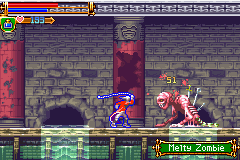
Demons: “wah, wah.”
In terms of combat, your standard attack is the ancestral whip that can also be periodically upgraded and buffed as new items are discovered. Complementing the default attack, you have many of the sub-weapons found in previous ‘Vania titles. While you can only carry one sub-weapon at a time and obtaining a new one results in dropping your current sub-weapon, each sub-weapon does have two attack variations: you can use both a regular attack that consumes hearts, similar to the earlier Classicvania titles, as well as one that consumes magic with the latter causing more damage and usually covering more surface area.
Adding to the sub-weapon variety are different spell books called tomes that can alter the mana-based sub-weapon attacks depending on which tome is turned on; there are fire, ice, thunder, and wind tomes each providing a different attack that adds an extra layer of depth to the meta game. While I enjoyed experimenting with different sub-weapon and tome combinations, I ultimately ended up finding something that worked and sticking with it most of the time and found that avoiding losing my currently equipped sub-weapon was as much a chore as the enemies scattered throughout.
While essentially an action platformer, Harmony of Dissonance incorporates some light RPG elements which have been commonplace in the 2D ‘Vania games since Symphony. Defeating enemies earns you experience points which will eventually raise Juste’s level resulting in increases of hit-point, magic and heart levels as well as increasing the amount of damage Juste can take. To add to the RPG-ness, you can also equip Juste with different items found throughout the game each with varying effects on offensive and defensive statistics as well as certain scenario specific items that help with navigation or reaching new areas. While limited, the RPG aspects do add to Harmony’s heterogeneity (a word I looked up just now) which does deepen the overall experience. Though during my playthrough I found very few game-breaking or must-have items and usually just equipped whichever items gave the best offensive or defensive stats.
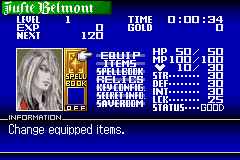
Exploration and finding new items and paths is a big part of Harmony’s experience. All gameplay takes place inside Dracula’s castle which is large and almost entirely open from the beginning. However, many areas remain inaccessible until the late game when you’ve obtained the proper relics and keys to reach them. Pretty standard Metroidvania stuff. Harmony’s big gimmick is that there are actually two castles with the second being a dark mirrored reflection of the first! These mirrored castles are similar to the main castle and the “upside down” castle in Symphony, though in Harmony the two mirrored castles must both be traversed to complete the game.
Each castle contains different steps to advance the castle map with some paths only available in one castle or the other; for example, breaking down a wall in Castle A may open up a new path in Castle B. One feature that made the dual castle system feel less daunting was the use of 3 maps; one map for each unique castle and then one that combines the two showing you which areas you’ve reached in both. This was a clever bit of execution that added a nice feeling of accomplishment each time I unveiled new parts of the map all while preventing me from having to flip back and forth repeatedly.
Unsurprisingly, portable games don’t usually feature such large and detailed worlds as Harmony’s massive castle, but that impressive size also works against it here. Throughout your journey, you’ll encounter portals that serve as a transport between the two castle versions but no portals that offer fast travel as seen in previous entries. Without any way to quickly trek across large portions of the map(s), Harmony’s backtracking, an integral part to the gameplay experience, feels like a massive chore rather than an incentive to explore and adventure.
The absence is especially frustrating when you consider that the series’s strongest entry, which is an older title, featured the ability to quickly move across the game world saving both time and frustration. It’s unclear if omitting fast travel was a creative design decision to pad the completion length, an oversight, or otherwise intentionally omitted but the choice truly drained my patience as well as sucked the lifeblood from this game’s pacing. VAMPIRE PUNS!
Outside of the pain of getting Juste’s ass from one end of the castle to the other, Harmony’s level of difficulty is not going to test your GBA’s durability against walls or tile floors. I rarely died during my playthrough and when I did it was almost always because I was too reckless. I overcame every boss battle with only the most basic of attack spamming and I rarely required the use of items if I entered combat with full health. Leveling up happens frequently in the first half of the game and the pacing at which you uncover new whip upgrades feels like Juste will almost always get too powerful before the game becomes a real challenge.
The underwhelming enemy difficulty and quick level-ascension lend to my theory that the huge amount of absolutely no fast-travel was an intentional design decision to pad game length especially when considering the bosses can be pierced like sunlight through a vampire. When a game makes you feel like avoiding enemies to save time instead of grinding through them to earn XP, it can get kinda long in the tooth.
Visually, Harmony emulates the style of its ancestors admirably which Koji Igarashi really wanted to do at the outset. Some of the animations seem to be missing frames especially when Juste is running but it’s hard to really notice, especially on such a small screen. The art style courtesy of Ayami Kojima adds a level of legitimacy and maturity to the character portraits and sprites making it feel like a premium game on a small screen. While the audio of Harmony is missing the voice acting performances of its contemporaries and the chiptunes-esque music feels dated (and a little uninspired), both do the job well enough. Considering the GameBoy Advance is little more than a suped up Super Nintendo, it’s a pretty impressive feat that Harmony looks and sounds as good as it does, but I felt somewhat underwhelmed by the presentation despite these caveats.
General Commentary
- This game does not have an incredibly strong story. Even by Castlevania standards, it’s not an overly deep narrative with story elements happening infrequently and seemingly with little impact other than game progression
- The soundtrack does not live up to the standards set by previous series entries, save for the absolute banger of a track Offense and Defense – the music is otherwise very disappointing
- Juste is a Belmont but it seems like more than a coincidence that his long, white-ish hair makes him visually closer to Alucard than his brown haired Belmont ancestors. This definitely seems like an attempt to tie Harmony back to Symphony in a less than subtle way
- It was definitely a trip to play this game as it reminded me heavily of when I first got a GameBoy Advance and how cool I thought it was. I think the GBA was a pretty cool piece of hardware for the early 2000’s and Harmony gave me a lot of nostalgic feelings for other titles I played and enjoyed
- The entire subplot and objective of needing to find the “pieces of Vlad” so Dracula can be defeated is recycled from Simon’s Quest further making Harmony feel like somewhat of a combination of previous series titles
- I played on the DS Lite instead to avoid hand cramping and to have better lighting, but even the DS Lite is kinda small… couldn’t imagine playing this on a GBA Micro without getting arthritis. Would be nice to be able to experience this comfortably without having to dredge through emulators – c’mon Konami, Anniversary Collection 2 on Switch would be real nice here
- I was unable to capture my own screen shots, so all in game captures I’ve used here are from user NeoJ from the website MobyGames.com – I used NeoJ’s images with permission and I wanted to shout out his blog and Twitter accounts to all my Spanish readers! Thanks again, NeoJ!
Verdict (Play It Now, Backlog It, or Skip It)
I definitely liked my experience playing Harmony of Dissonance, but truthfully I ended the experience feeling a resounding ‘eh.’ The low difficulty and the repetition with no fast-travel really made what could have been a 4-5 hour game last about 7-8 hours all the while feeling inflated and less enjoyable. The controls feel responsive and easy to pick up and exploration is still mostly satisfying, even if long and arduous at times. Visuals and sound are fine – they won’t blow you away, but when you remember the hardware this game was designed for, it’s easy to be a little more forgiving.
If you’re a die-hard fan of Castlevania or Metroid, I’d say you’ll definitely want to pick up Harmony, regardless of when you get around to it. Even with its flaws, it’s a solid experience, especially for those of us that are bloodied veterans. By the time you get around to it, you won’t regret your time, but it’s not something you need to dust off the GBA for right after reading this review. If you’re more of a Casualvania, I’d say skip it and try one of the other GameBoy titles first to see if this is the kind of game you’ll enjoy and then come back if you’re looking for more.
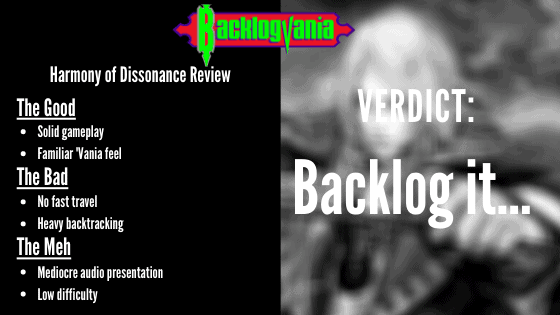
Rating: Backlog it…
Final Thoughts and Next Game Up
Though there are other Castlevania games in the backlog, and in spite of the fact that I’m looking forward to completing my collection with the remaining games on my list, I will likely not play another game in the series for a while. Mostly to prevent these from becoming stale.
For the next up, I’ll be taking a look at one of my favorite games of all time that has vexed me for over two decades… Xenogears. A game I have started and nearly finished more times than I can count, but a game that I have yet to finish in its entirety. Come see why it’s one of my favorite games I’ve ever played without me ever fully completing it and see if that opinion still holds up when I finally finish it.
